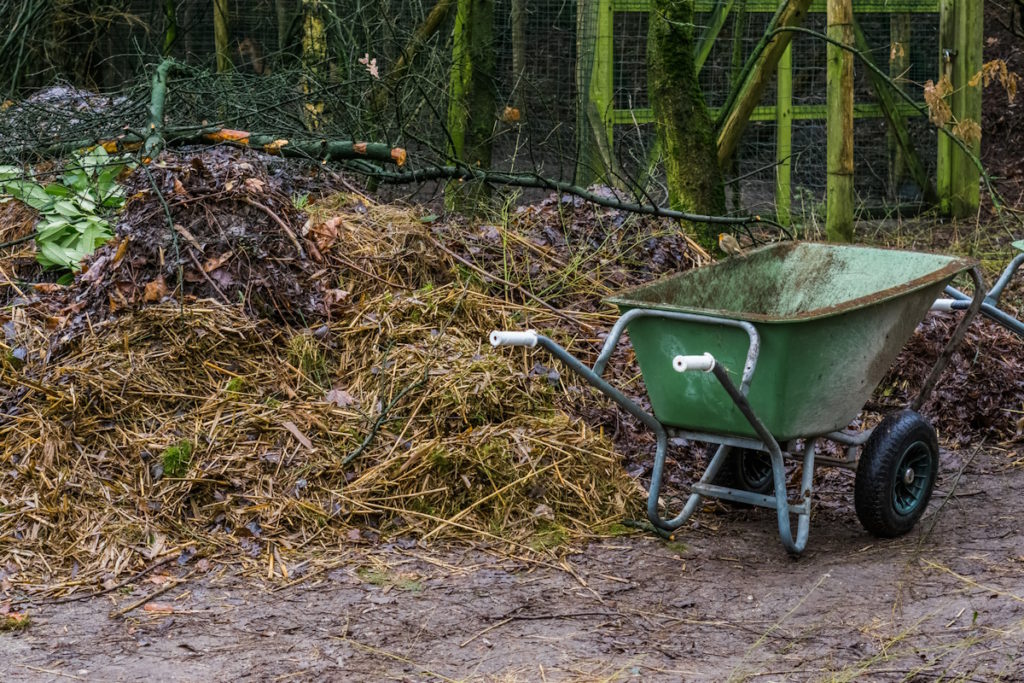Composting is a natural process that transforms organic waste into nutrient-rich humus, benefiting the environment and our gardens. However, sometimes the composting process can become slow or stagnant, resulting in a pile that fails to decompose efficiently. This article will explore the common causes behind slow or stagnant composting and provide practical troubleshooting steps to help you revive your compost pile and achieve successful decomposition.
Understanding the Composting Process
Composting is a natural process that involves the decomposition of organic matter, like food scraps and yard waste, into a nutrient-rich soil conditioner known as compost. This process is primarily facilitated by microorganisms such as bacteria and fungi, along with larger creatures like worms and beetles, which break down the organic material into simpler substances. Composting helps recycle organic waste and enriches the soil with essential nutrients, improving its structure and promoting healthier plant growth.
Composting is a natural process, meaning that normally we don’t have to do anything other than provide the material to make it happen. However, there is a bit of a recipe involved, which means that we have to have the right mix of ingredients for composting to take place efficiently. The main ingredients are
- Carbon Rich Brown Materials – Such as leaves, paper, cardboard, and other similar substances
- Nitrogen Rich Green Materials – Examples of these include most fruit and vegetable scraps
- Water – Water is a vital component of the composting process and supports the organisms that carry out the aerobic decomposition of your compost. Too much water, however, isn’t good for your compost.
- Oxygen – The microorganisms that do the actual composting need oxygen. Without it, they can’t survive, and anaerobic decomposition will occur, which is basically rotting. This is less efficient than aerobic decomposition causing a smelly, nasty mess. This is the same process that occurs in landfills.
Some compost systems will have worms and maybe more heat or use slightly different chemical processes, but this covers most compost piles (including those with worms, which require the same parts). Composting with worms is called vermicomposting.
If these things aren’t available in the right proportions, then your compost pile might decompose more slowly or not at all. When a compost pile stops composting, we say it is stagnant compost.
How to Recognize Slow or Stagnant Composting
Usually, it’s pretty easy to recognize a slow or stagnant composting pile. Here are some things you want to look for if you think your compost pile has slowed or is stagnant.
- Lack of Temperature Rise: In an active composting process, the temperature should rise and remain consistently warm or hot (around 130-160°F or 54-71°C) due to microbial activity. A lack of temperature rise indicates a slowdown in decomposition.
- Absence of Visible Decomposition: In a healthy compost pile, organic materials gradually break down, transforming into dark, crumbly humus. However, if you notice that the materials in your compost pile remain largely unchanged over an extended period, it clearly indicates slow or stagnant composting. The presence of recognizable food scraps or plant matter without any signs of decomposition suggests that the microbial activity is insufficient.
- Foul Odors: Compost properly functioning piles emit a mild, earthy smell. However, a stagnant compost pile may develop foul odors, such as a strong ammonia-like smell or a rotting odor. They stink. These unpleasant odors are typically caused by anaerobic conditions, where the lack of oxygen promotes the growth of odor-producing bacteria instead of the beneficial aerobic microbes responsible for decomposition.
- Lack of Earthworm Activity: Earthworms are valuable contributors to the composting process, aiding in decomposition and enhancing nutrient availability. Even if you aren’t vermicomposting, you often will see worms in your compost. If you observe a lack of earthworms (or composting worms if you’re vermicomposting) in your compost pile, it may indicate slow or stagnant composting. Earthworms prefer an environment rich in organic matter, moisture, and aeration, so their absence suggests an unfavorable condition for survival and activity.
It is important to note that occasional slow periods can occur in composting, especially during colder months or when using certain materials. However, if multiple signs persist for an extended period, you must troubleshoot the compost pile to fix the underlying issues and restore active decomposition. Thankfully, it’s usually pretty easy.
The Potential Reasons Behind Slow or Stagnant Compost
Various factors might be to blame if you’re experiencing a sluggish compost pile. We will explore the possible reasons behind slow or stagnating compost, offering insights so we can talk about solutions. The good news is that all of these are interrelated, and often one solution can address multiple potential issues.
- Not Enough Time
Composting takes time. The shortest things to compost take several weeks, and many items take several months. Composting doesn’t take a lot of work, but it does take patience. Make sure you give it time for the process to take effect.
- Imbalance of Carbon and Nitrogen
In an ideal composting scenario, the balance of carbon (brown materials like dried leaves, straw, or paper) and nitrogen (green materials like vegetable scraps, coffee grounds, or fresh grass clippings) is crucial. The optimum ratio is generally agreed to be about 30:1, carbon to nitrogen. If this ratio is off-balance, it could result in a slow decomposition process. Too much carbon can lead to a slow process, while excessive nitrogen can lead to a smelly, slimy pile.
See Also: Ratio Article, Brown Materials, Green Materials
- Inadequate Aeration
Oxygen is essential for decomposition, as the microorganisms responsible for breaking down organic matter are predominantly aerobic, meaning they use oxygen. Without adequate aeration, these microorganisms can’t do their job efficiently, slowing the composting process. This problem is often associated with compost piles that are too densely packed or not turned regularly.
For More Information, See Remedying Poor Compost Aeration
- Insufficient Moisture
Water plays a significant role in composting, as it helps maintain the compost pile’s temperature and supports the survival and activities of microbes. If your compost pile is too dry, decomposition will slow down because the microbes require moisture to thrive. On the other hand, an overly wet compost pile can become anaerobic, leading to unpleasant odors and slowing the composting process (and creating a nasty mess).
See Also: Recognizing and Correcting Insufficient Moisture in Compost
- Inappropriate Temperature
Compost piles need heat to facilitate rapid decomposition. The heat is produced internally from the metabolic activity of the microbes that are causing the decomposition. A compost pile that doesn’t heat up or gets too cold may stagnate. However, if the compost pile becomes too hot, it can kill off beneficial microbes, slowing the composting process. We need it just right.
See Also: Importance of Proper Compost Temperature Control
- Incorrect Size of Compost Materials
The size of materials you add to your compost pile can also influence the speed of decomposition. Larger items take longer to break down than smaller ones. Thus, the decomposition process will likely slow down if you add large branches or big chunks of food waste to your compost pile without breaking them down into smaller pieces.
When you look at any of our articles on whether you can compost something and how, one of the first recommendations is almost always to break the item up, grind it up, rip it up, etc. This is to facilitate decomposition and make the composting process faster, or, in some cases, possible because the size or density of the item could take a very long time to decompose.
- Lack of Microbial Diversity
A diverse microbial population is critical for efficient composting. These microbes include bacteria, fungi, and other organisms that work together to break down organic materials. If your compost lacks microbial diversity, the decomposition process might be slower. To boost microbial diversity, consider adding a compost starter or well-composted manure (or, ironically enough, compost). While the necessary microbes will naturally find their way to a compost pile, these all have microbes in them to start the process.
You’ll also find that many of the steps are similar (or even the same), so a couple of actions can cover several potential problems.
Troubleshooting Steps to Revive Your Compost Pile:

Taking the right steps to fix your stagnant compost pile is largely a matter of doing many of the same things you do to take care of your compost pile. The good news is that you generally can’t do much harm. Often, you won’t know the exact cause. For example, seeing microbial diversity without a biology degree and a microscope is tough. However, doing all of these steps will rarely make things worse.
The first thing is to make sure you’ve given it some time. Consider taking these actions if you don’t see any movement after a few weeks.

Inadequate Aeration
The microbes that do the bulk of the work in composting require oxygen. If there isn’t enough oxygen, your compost will decompose anaerobically (basically, it will rot). This will slow or stop the composting process.
Smelly, stagnant compost can indicate inadequate aeration in your compost. Compost that is densely packed together will also often lead to poor aeration. This happens because there isn’t enough space between the material to allow air into the compost pile itself, which is where the microbes do most of their work.
Don’t think you’re immune if you’re using vermicomposting (composting with worms). Vermicomposting also uses microbes, and the worms need air to survive.
The best fix for inadequate aeration is to mix up your compost, called turning. You can either do this by hand or using a compost aeration tool. This helps to mix air into the compost pile. You’ll find that turning your compost is a solution to many problems.
In addition to turning, you can add bulkier brown materials like sticks, twigs, leaves, and cardboard. Even cut up, as we normally do, these materials will structure into your compost pile and create air pockets that allow air to get trapped when you turn your materials. They also prevent your compost from becoming too dense, which keeps air pockets form forming.
Make sure that you’re breaking your compost material into smaller pieces. Large pieces take longer to compost, disrupting the composting cycle and creating a densely packed compost pile.
Lastly, if you’re using a container to compost in, ensure it has holes to allow aeration. Most commercial compost containers will come with holes, but if you are using a bucket or bin to compost in, you may need to drill holes to allow for aeration.
Read More: Ensuring Proper Compost Aeration

Insufficient Moisture
If you don’t have enough moisture in your compost, the microbes can’t survive very well and the composting process can’t occur (or at least won’t occur very quickly.) Insufficient and too much moisture can lead to a stagnant compost pile. So, the first step will be to determine which is the case.
Hold your compost in your hand and squeeze it, or use a soil moisture meter. It should be the consistency of a wet sponge. If a lot of water comes out, it has too much moisture. Similarly, if it has mold growing, it’s probably too moist as well. If it’s dry and flaky, it doesn’t have enough and you need to add water. Add water, making sure to turn your compost as well, until it has that wet sponge consistency.
Read More: Correcting Insufficient Moisture in Compost
Too Much Moisture
If your compost has too much moisture, we must reduce that. The easiest way to reduce the moisture is to add brown material to help absorb the moisture. You might want to do this over a few days not to dry out your compost. Make sure to turn your compost after adding the brown material so that it gets mixed into the compost. Having it sit on top won’t do much for you.

Inappropriate Temperature
An incorrect temperature can prove to be a significant roadblock in compost’s ideal decomposition. Various factors contribute to temperature discrepancies, such as moisture levels, oxygen supply, the size of the compost pile, and the balance of green and brown materials.
Ideal composting occurs when the pile’s temperature ranges between 130 to 160 degrees Fahrenheit. In this zone, thermophilic bacteria can thrive, efficiently breaking down the compost material. However, lower or higher temperatures can hinder this process, leading to poorly decomposed compost or unpleasant odors.
Low temperatures (below 130 degrees Fahrenheit) may occur due to insufficient nitrogen-rich green material, lack of oxygen, or inadequate moisture. This scenario encourages mesophilic bacteria that operate best in lower temperatures, slowing down the composting process.
On the other hand, excessively high temperatures (above 160 degrees Fahrenheit) can result from too much green material or an overlarge pile, causing thermophilic bacteria to work overtime. This extreme heat can kill beneficial microorganisms and might lead to the pile becoming anaerobic, leading to odorous emissions.
Addressing the incorrect temperature issue requires careful troubleshooting. If the pile is too cool, consider adding more green material, turning the pile to add oxygen, or watering it to increase moisture. Conversely, if the pile is too hot, turning the pile more frequently can help regulate its temperature. In some cases, it might be necessary to reduce the size of the compost heap or balance it with more brown materials.
Maintaining an optimal temperature in your compost pile is crucial to efficient decomposition. By understanding the causes of temperature fluctuations and ways to counteract them, you can ensure your composting process remains effective and beneficial to your garden.
Read More: The Importance of Proper Compost Temperature Control
Incorrect Size of Compost Materials
Having large pieces of compost material will slow down the process. There is less surface area for the microbes or worms to work on. Imagine them nibbling at the edges. Large material is fewer edges that they can nibble on (it’s not exactly true, but it works).
The solution here is obvious but can be a bit messy. Reach in, break up, rip, or tear up the material to make it smaller. Especially in a healthy compost pile, the larger pieces would eventually break down, but they could take months or more. So, you are best off breaking things up before adding them.
A slow or stagnant compost pile can be really frustrating, especially when you’re getting started. At it’s best, composting isn’t a fast or exciting process. However, it can be really exciting when you go to add that beautiful black gold to your lawn or garden, realizing that you made it from what would have been trash and it will help your lawn and garden. Once it gets going, it’s fun to see the fruit of your labor but when it’s not working, it’s frustrating and maybe even smelly.
